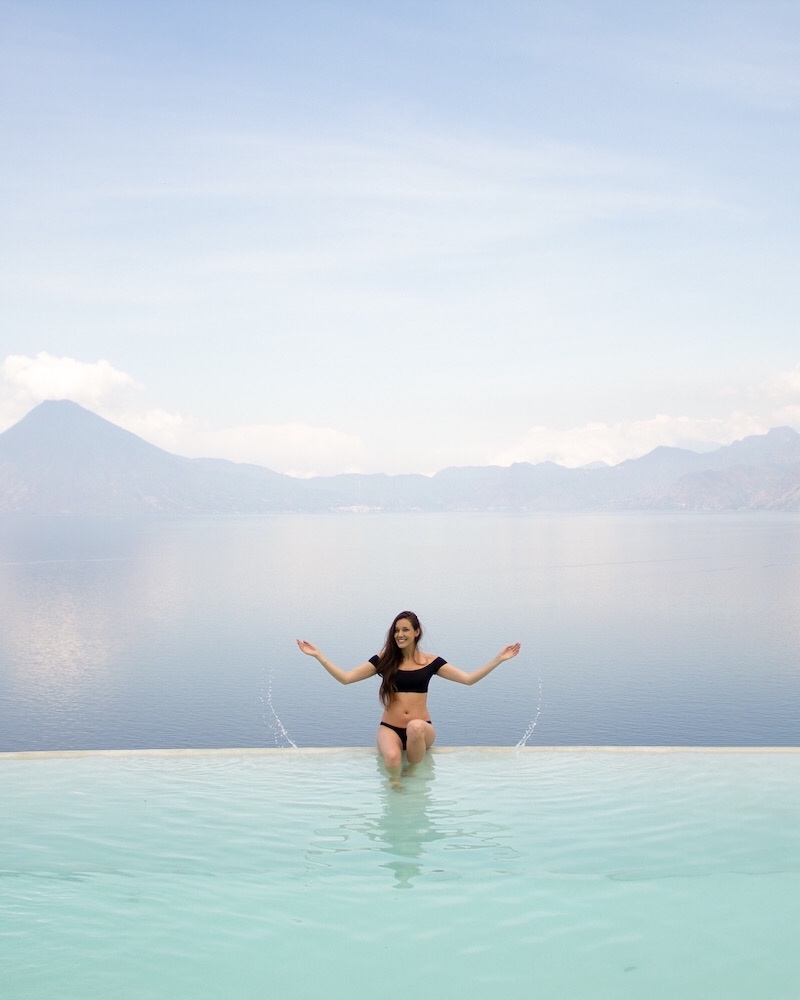How to Get Comfortable Planning a Solo Ski Trip
/I learned how to ski as an adult, and it didn’t take me long to realize how much I loved it. However, it’s a sport that’s often associated with its high barrier-to-entry: due to the expense, the limited access to skiable areas, the physical effort, and the feeling that you needed someone to accompany you. But I was determined to get better at skiing and spend as much time on the mountain as possible– and when I’m determined, I get creative.
I started to think of skiing on-piste as being similar to many other sports that can be practiced without waiting for anyone else: like cycling, running, or playing golf for example. As someone who had already traveled solo to a number of destinations around the world, I realized that I never let “not having someone to go with me” stop me from following my dreams. I expressed to family and friends that I was interested in skiing on my own and was originally met with worry for my safety, but went anyway. And as time went on and I continued planning ski trips on my own (eventually through 50+ stations across 8 countries), that worry turned to admiration and support, and many kind words from others that were inspired to do the same.
I’m grateful that my passion for skiing has led me to some of the most iconic destinations in the world, and just this last season I surpassed my 100th day solo-skiing (which accounts for about 2/3 of all the skiing I’ve ever done!). Not only has the experience been personally rewarding and a lot of fun, but I’ve also been able to improve considerably thanks to the sheer amount of time I’ve spent on the mountain.
If you’re wondering how to get comfortable skiing alone and how to start planning your own solo ski trips, keep reading to discover the tips that personally helped me.
Very important note: all of the claims and recommendations made in this article are based on my own experiences skiing alone on-piste, within bounds of designated ski stations or resorts. I would never recommend skiing alone off-piste or in the backcountry.
How to Get Started Skiing Solo
1. Start small
Even if you have your heart set on someday skiing iconic destinations, you can get some valuable experience by starting small to build confidence. Consider going to a station you’ve already visited and are familiar with, or taking a day trip to your nearest ski station to see how you feel. As you get more comfortable going through the motions, the more natural and less “awkward” the experience will feel.
2. Practice traveling solo if you haven’t already
When you get familiar with the logistics of planning a solo ski trip, you learn it’s not entirely different than planning any other type of solo trip. I wrote a full guide on this topic: How to Get Started Traveling Solo, which describes in more detail about how gaining experience and getting familiar with your own personal travel habits will help you make better choices as you continue traveling to more destinations. The more comfortable you get with booking your own reservations, spending time with yourself in new places, and discovering how exactly you like to travel, the more naturally it will come to you when you venture out on a solo ski trip.
3. Practice taking the lead in navigating when skiing with others
If you have the opportunity to ski with others, communicate that you would like to try taking the lead when planning the day or navigating the slopes. Getting familiar with navigating trail maps is one of the most important skills you can develop as a solo skier. And the more experience you get, the easier it becomes. If you’re already the trail map navigator of your group, you’re already well-prepared for a solo ski trip!
4. Study the trail map ahead of time
You can also be prepared before arriving to the mountain by studying the trail maps of your destination. Getting familiar with the names of the lifts, gondolas, and runs that you may be interested in discovering can help give you a boost of confidence while you’re skiing, and having a route or a plan in mind will give you a better sense of direction.
5. If your group wants to end the day earlier than you want, keep going and catch up with them later
Sometimes when you’re on a ski trip with others, you may find that they may not want to ski as much as you do. If your group wants to call it a day much sooner than you’re ready to and you have the means to reconvene later, let them know you want to keep going. If you communicate clearly and honestly you can avoid any hard feelings, and can make the most of your ski day even if the rest of your group prefers to spend their time relaxing instead. Similarly, if your group prefers to start their morning slowly when you’re eager to get first tracks, communicate that you’ll be heading out on your own and that you can meet up on the mountain whenever their ready. Taking initiative is admirable, and letting others in your group take their time instead of feeling rushed should be appreciated.
6. Choose accommodations close to the slopes
When you’ve chosen the destination for your solo ski trip and are researching accommodation options, keep in mind that minimizing the distance you have to travel to and from the mountain each day will make it a generally safer experience. Avoid having to drive long distances alone in wintry conditions if you can– if your commute to the mountain is already stressful, it may make your ski day or your trip a little less enjoyable.
7. Choose a hotel and notify the staff if you feel comfortable
If you’re staying in a hotel, consider letting the receptionist or someone on the staff know that you’re on a solo ski trip if it feels appropriate and safe. Not to put pressure on anyone else to feel like they are responsible for your safety, but if you happen to establish a friendly rapport with someone on the staff while you are checking in for example, it could be helpful to have someone local potentially looking out for you.
8. Book a lesson with an instructor
One of the main motivating reasons why someone may be interested in skiing solo is if she doesn’t have someone to go with her when she wants or is able to. If this sounds like you, you could book a lesson with an instructor or a guide to teach or accompany you on the mountain. Doing so is certainly more affordable in ski destinations in Europe, but some resorts in the US will also offer group lessons that match you with other skiers that have a similar level. Booking a lesson on your own, whether private or with a group, will help you gain valuable experience of traveling to and arriving to the mountain solo, which is an important skill in-and-of-itself.
9. Share your location with others
I use the Slopes App which has a number of safety features, all of which I wrote about here in this guide: My Favorite Ski Safety Features on the Slopes App. My favorite feature is the ability to share your location with others, even if they aren’t skiing with you and even if they don’t have the app downloaded. Simply enable location sharing while you are tracking your ski day, and share your link with anyone who will follow along as you make your way around the mountain. Every day that I head to the mountain to ski alone on-piste, I send my mom my location (even if she’s halfway across the world) so that someone is aware.
10. Practice these safety tips
I’ve written a more detailed guide with all of my top safety tips for anyone who plans to ski alone, which you can read here: Practical Safety Tips for Skiing Alone On-piste. You may find that these tips can also be generally helpful for anyone who practices the sport, but are especially important if you head to the mountain on your own. Tips like using RECCO Rescue Reflectors, avoiding use of headphones, and wearing bright visible colors can help you have a safer experience– read the full guide here.
12. Enjoy the freedom!
The biggest benefit of planning your own solo ski trip is the freedom– pick a destination on your bucket list, go at your own pace, arrive and depart as early or as late as you want– the choices are all yours! I’m grateful that following my passion has led me to ski in some unforgettable destinations, all while enjoying the beauty of the mountains, getting exercise, and hopefully inspiring others to do the same.
Thanks to all the experience I’ve gained on my solo ski trips, in just a few seasons I was able to progress enough to confidently ski La Vallée Blanche in Chamonix France which had long been on my bucket list. This was a big personal accomplishment that I was also able to do during a solo ski trip– I easily booked a spot to join a small group with a local guide through Evolution2 Chamonix. In fact, there were two other solo skiers in my group. It always makes me happy to see others also following their dreams, and not waiting for anyone else to do so. And the more time you spend on the mountain skiing solo, the more you’ll notice how many others are out there doing the same.
Are you considering skiing on your own and have questions about my experience? Let me know in the comments below!
You may be interested in:
How to Improve Your Skiing as an Adult: Tips You May Not Have Thought of Yet
Tips for Choosing a Ski Lease: The Remote Worker's Guide to Relocating to a Ski Town
Ski Trip Skincare - Only Three Essentials to Protect Your Skin in Winter
Ski Gear: What to Buy Second Hand, and What to Buy Brand New
My Bucket-List Ski Experiences: Inspiration for Your Winter Travels
RECCO Rescue Reflector: A Must Have for Any Skier or Outdoor Adventurer
About the author
Meet Carina Otero, avid skier and the creator of She is Not Lost, an online community for celebrating female travelers and a blog providing helpful tips, useful information, and inspiration for your future travels. Carina’s passion for skiing and love of writing and photography have inspired a new blog to share her experiences and personal favorites relating to the sport:
Discover Ski is Not Lost
This post may contain affiliate links and at no cost to you, I may earn a commission which allows me to keep this site free for all readers. I only recommend properties, products, brands, and services that I personally use and believe in.










































